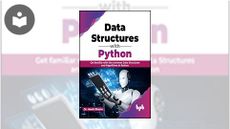Analyzing Data Using Python: Importing, Exporting, & Analyzing Data With Pandas
Python
| Intermediate
- 10 videos | 1h 22m 35s
- Includes Assessment
- Earns a Badge
You can analyze a myriad of data formats through pandas - all you need to know is how. In this course, you'll bring various data types into pandas and perform several operations on the data. You'll practice using common file types such as CSV, Excel, JSON, and HTML through pandas. You'll not only learn how to open and read files of different types, but you'll also serialize objects and copy them to the in-memory clipboard. You'll move on to perform various fundamental operations on DataFrame objects. Lastly, you'll learn to compute basic statistics, access metadata, and modify and sort data in rows.
WHAT YOU WILL LEARN
-
Discover the key concepts covered in this courseImport and export data in csv filesImport and export data using html and json filesSerialize data to excel and pickle filesPerform basic data manipulation operations on dataframes
-
Explore and edit data in dataframesSort records based on column valuesCompute basic statistics on data stored in dataframesCompute statistical summaries on data stored in dataframesSummarize the key concepts covered in this course
IN THIS COURSE
-
2m 15s
-
8m 36sIn this video, you'll learn how to import and export data in CSV files. You'll discover that DataFrames and Pandas organize data into rows and columns. Every row can be identified using a unique value of the index. The unique value is called the label and every column can be identified using the column header. FREE ACCESS
-
3. Importing and Exporting Data in HTML and JSON Files12m 46sIn this session, we will be working with the HTML and JSON file formats. HTML files are used to store data in a human-readable format, while JSON files are used to store data in a machine-readable format. We will first create a CSV file containing data in the form of objects, and then export that data to a JSON file. FREE ACCESS
-
4. Reading and Writing Excel Files Using DataFrames9m 34sIn this video, you'll learn how to serialize data to Excel and Pickle files. You'll follow along with a demo in which you'll turn your attention to the common file format, the Excel file format. Along the way, you'll also see how pandas DataFrames can be serialized and deserialized, and how they can be written to the clipboard. FREE ACCESS
-
5. Performing Basic DataFrame Operations12m 29sIn this video, you will learn that there are many common operations on pandas DataFrames. You will learn how to perform basic data manipulation operations on DataFrames, including sorting and filtering. FREE ACCESS
-
6. Computing Unique Values and Renaming Columns7m 27sIn this video, you will learn how to discover and edit data in DataFrames. You will follow along onscreen as you learn about exploratory data analysis operations using Python DataFrames. You will also encounter a common but nasty pandas gotcha. FREE ACCESS
-
7. Sorting Data Based on Specific Columns7m 9sIn this video, you'll learn how to sort records based on column values. You'll discover that there's nothing wrong with sorting the values in a DataFrame. Instead, you'll learn to understand it carefully because the first input argument into sort_values is a column name and the second input argument is the sort type. FREE ACCESS
-
8. Computing Basic Statistics6m 53sThis session is about computing basic statistics on data stored in a pandas DataFrame. The presenter will discuss how to use the describe function, drop method, head method, and idxmax function. FREE ACCESS
-
9. Computing Univariate and Bivariate Statistics12m 37sIn this video, you'll learn how to compute statistical summaries on data stored in DataFrames. You'll start by exploring the mean. Next, you'll calculate the median, which is also called the 50th percentile. Then, you'll learn that the mode is the most commonly occurring value or set of values. FREE ACCESS
-
10. Course Summary2m 49s
EARN A DIGITAL BADGE WHEN YOU COMPLETE THIS COURSE
Skillsoft is providing you the opportunity to earn a digital badge upon successful completion on some of our courses, which can be shared on any social network or business platform.
Digital badges are yours to keep, forever.





